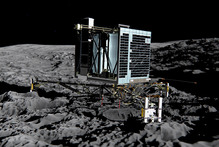
Kiwi help in historic space hook-up
By Jamie Morton @Jamienzherald
5:00 AM Friday Aug 1, 2014

The Rosetta spacecraft's Philae robotic landing craft above comet 67P/Churyumov-Gerasimenko artist impression. Photo / Supplied
Kiwi-developed technology will assist a historic hook-up when a spacecraft makes its long-awaited date with a comet next week.
On Wednesday, the European Space Agency's probe Rosetta will reach the 3km-long 67P/Churyumov-Gerasimenko and begin planning an astonishing first in space exploration - landing on the surface of a comet.

Since its launch in 2004, Rosetta has travelled more than six billion kilometres to catch up with the rubber duck-shaped comet.
Once there, Rosetta will begin synchronising its orbit with the giant space rock, which is hurtling through the solar system at a speed of 400,000km/h.
Later in the year, the probe will drop its Philae lander to dock on to the comet's icy surface. The comet has almost no gravity so the probe will have to use harpoons and ice anchors to clamp on to the surface.
Following the mission closely are engineers at New Zealand-based tech company Rakon, whose special frequency-control technology is a crucial component of Rosetta's mission.
The world-renowned company's crystal oscillators and crystal filters are used in Rosetta's Comet Nucleus Sounding Experiment by Radiowave Transmission (CONSERT), which is designed to probe the comet's interior by using radio waves transmitted through the nucleus between the Philae lander and Rosetta orbiter.
"I guess it's the most out-there and exciting," said Rakon chief executive Brent Robinson, when asked how the mission compared with other space projects the company has been involved with.
"It's a world first, and Rakon is delighted to be involved in a project that will help us to understand our universe, and how it all came about."
The comet was selected because it followed orbital paths near the ecliptic plane, or path of the sun, making a rendezvous and landing easier to achieve, and also because its flight in the inner-solar system coincided with the mission timeline.
By studying the comet's dust and gas, Rosetta will help scientists learn more about the evolution of the solar system, of which comets are considered primitive building blocks.
As the comet comes into contact with heat and solar winds, scientists will also be able to observe how these giant bundles of rock and ice respond at relatively close distance to the sun.
Stardome astronomy educator David Britten said the landing as the comet rotated in its ultra-fast orbit was going to be tricky.
"As it gets closer, it will obviously be able to see the comet in much more detail, and it could just be a bit of rubble held together by ice."
Mr Britten said it was possible that learning more about this comet could help scientists better prepare for the threat of a comet on a collision course with Earth.
By Jamie Morton @Jamienzherald
- NZ Herald
Copyright ©2014, APN New Zealand Limited

